|
FAQs on Anemones of the
Caribbean/West Atlantic 2
Related Articles: Anemones,
Anemones of
the Tropical West Atlantic, Colored/Dyed Anemones,
Related FAQs: Atlantic
Anemones 1, Condylactis,
Tropical
West Atlantic (TWA) Anemone Identification, TWA Anemone
Behavior, TWA Anemone
Compatibility, TWA Anemone
Selection, TWA Anemone
Systems, TWA Anemone
Feeding, TWA Anemone
Disease, TWA Anemone
Reproduction,
FAQs by Genus: Actinoporus, Arachnanthus, Bartholomea, Condylactis
(see below), Epicystis, Lebrunia, Sticholdactyla helianthus, Viatrix, Others/Unknowns,
& FAQs on:
Anemones 1, Anemones 2,
Clownfishes & Anemones,
Anemone
Lighting, Anemone
Reproduction, Anemone
Identification, Anemone
Selection, Anemone Behavior,
Anemone
Health, Anemone
Placement, Anemone
Feeding,
|
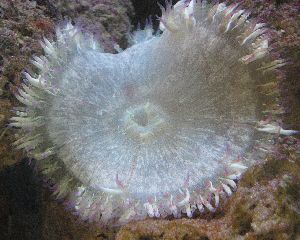
Epicystis crucifer, Flower Anemone, aquarium
pic.
|
 |
New Print and
eBook on Amazon:
Anemone Success
Doing what it takes to keep Anemones healthy long-term
by Robert (Bob) Fenner
|
Rock Flower Anemone Questions
7/13/10
Hey James.
<Jordan>
I searched your website, and I haven't found anything on what
I'm trying to figure out. So I have a clarkii clownfish that hosts
in a Condy anemone in my 10 gallon reef,
<Too small a tank for that combo.>
and in my 37 gallon I have an ocellaris clownfish pair that are very
aggressive and won't let me add any fish to the tank (new fish are
almost always dead the next day from the clownfish attacking them).
What I want to know is whether or not there is a chance that if I
switched the clownfish whether or not I could add a rock flower anemone
that the clarkii will host. The clarkii is wild caught.
<Is unlikely that your clarkii would host a rock anemone.>
I also want to know whether or not the lighting I have on the 37 gallon
is enough, it's a FOWLR with 65 watts of
PC (50/50 bulb). I've read in a ton of places saying that my
lighting would be fine if I kept the bulb fresh, but I've also read
that it isn't enough. I'm not sure but any help would be
great.
<Is not enough lighting for any of the anemone species your clarkii
would host. Except for the Bubble Tipped Anemone (BTA), all will
require intense lighting.>
Thanks.
<You're welcome. James (Salty Dog)>
Re Rock Flower Anemone Questions 7/13/10 - 7/14/10
So your <you're> saying that a buble <Bubble> Tip
Anemone would do fine in a 37gal with 65 watts
of PC?
<No, I said that of all the anemones clownfish would host, all but
the BTA would require intense lighting. One 65 watt lamp would be
border line at best for the Bubble Tip Anemone. Twin 10-12K lamps
should provide the light intensity they require.>
I know that most anemones need intense light but I've been told
that Rock Flower Anemones will adapt to very many light intensities and
usually don't need high light at all.
<You are correct, Rock Flower Anemones (Epicystis crucifer) do well
under moderate lighting. My point was that it is unlikely that your
clownfish would host this anemone species.
James (Salty Dog)>
|
Need help identifying anemone -- 03/18/10
I've attached three pictures of a strange anemone. It lives
in the sand at about the 10 foot depth, and is usually covered
with sand during the day (see picture #1), although sometimes I
can see it, especially in the late afternoon. At night it comes a
little above the sand and looks like picture #2. When my dive
light attracts a worm or small fish to the anemone, it closes up
as in picture #3.
These pictures were taken on Bari Reef on Bonaire, Netherlands
Antilles.
It is about 1 1/4 to 1 1/2 inches in diameter. Any idea of what
it is?
Thanks,
Marge Lawson
<I've been to Bonaire a few times... it is a treasure for
divers... but have not seen this beautiful anemone (though do
occasion Cerianthus in the shallow sands... in about the same
environment, quite often). I've looked in my references, on
the Net, and I can't place this animal. I would send your
images along to Daphne Fautin (Hexacorallians of the world .com)
in the hope that she might know, or be able to find you someone
who does. Thank you for sharing. Bob Fenner>
|
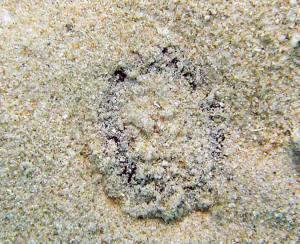 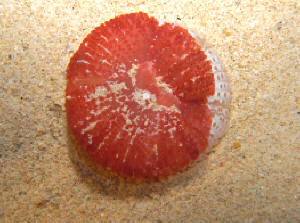
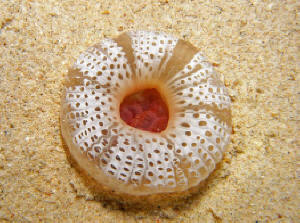 |
Re: AndyB pc. on Dendro and no Aiptasia in the
Atlantic claims 2/17/08 Bob, <Andy> I will be happy to
help in any way I can, but I must caution that I have no biology
background or experience with preparing/writing such works. <Au
contraire my friend. You obviously have a good grasp of written English
communication... and enough "science" to relate your
experiences here. I assure you of this> If you can provide a little
more specific guidance on what, exactly, you're interested in (what
type of photos, what type of specs, what type of narrative, etc.), I
will gladly take this on. <Images of your system, the foods used,
the specimen itself from a few angles, perhaps under various
lighting... The writing, in your own voice... simply detailing your
interest, background... the history of your keeping this specimen...
Speculations you have, may have re your success> On another note, I
have a question about Aiptasia. I have been debating this issue with a
LFS owner, which sells Florida aqua-cultured LR exclusively. He claims
that his LR is guaranteed Aiptasia-free, because they do not exist in
the Atlantic/Caribbean. <Uhh, not so> His claim is as follows:
"OUR FLORIDA AQUA CULTURED "LIVE ROCK" IS HAND PICKED.
IT IS LEGALLY HARVESTED AFTER 6 - 16 YEARS. SHIPPED WITH HEAT PACKS OR
ICE PACKS AND (WHICH EVER IS NEEDED) WITH ANEMONES, SEA SQUIRTS,
MUSSELS, GORG.S., SPONGES, STARFISH, TOOTH CORALS AND BRAIN CORALS ALL
OF WHICH LIVES. NO NEED TO CURE BECAUSE NOTHING IS "DYING".
APPROX. 6 HOURS FROM THE BOTTOM OF THE OCEAN TO THE BOTTOM OF OUR
TANKS. NO APTASIA IN THE ATLANTIC!" My research suggests that
Aiptasia do, indeed, come from the Atlantic. <This is also assuredly
so... Have seen them there, many times...> Interestingly, I believe
the Aiptasia that I did have in my tank (before the Butterfly) were
acquired from a few pieces of LR that I bought from him. Andy <Do
send this note to the company, rep... Perhaps their mis-spelling of the
genus is some ploy at avoiding suit. BobF>
DomRep Sea Anemone Identification 10/5/05 Hi!
<Hello Uli> I found your website http://www.wetwebmedia.com/marine/inverts/cnidaria/anthozoa/twaanemones.htm
looking for help. I need to identify an anemone. Please find jpgs
attached. I could not yet find it anywhere! By the way: I was not
the photographer, "it" was not touched to see a reaction,
all we have is the photo shot in the Dominican Republic. Any
idea?
<Appears to be an Actinodendron species. Mr. Fenner
may have some input here. James (Salty Dog)>
<<I concur. RMF>> Thanks a
lot! <You're welcome> Uli
Biologist
Germany |
|
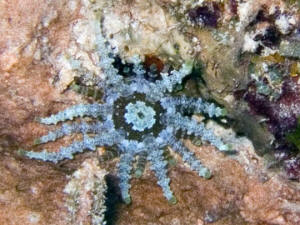
|
| Flower Anemone lighting? Hey guys and
gals <Bryan> First question in a long time from me, my tank
has been doing well, as have I. <Good> About 8 months ago I
built a canopy and installed 175watt Metal halides. The whole time
we have had a tank my wife has wanted an anemone, and since I
finally felt I had the light for it I bought a flower anemone. I
have attached a picture. Anyway, to make a long story short I could
not deal with the Metal halide lights due to excessive heat,
evaporation and a real problem with hair algae anywhere the light
actually shined on. For those reasons I got rid of the metal
halides and went back to my Fluorescent lights the tank came with.
They are Coralife 50/50 20 watt bulbs, 2 of them. <... in how
deep a tank? You switched these out... cold turkey I take it>
Now on to the question. The anemone seems happy, it's been a
couple of months now with the fluorescents, and it seems fine.
<All right> It has stayed in one place ever since I got it.
When I got rid of the MH's I tried to remove it without
success, its foot or base is deep in a hole in the biggest rock in
my tank (size of a cinder block) Will this light support it long
term? If not what is the minimum amount of light I can get away
with and of what type. Thanks, and I enjoy the site Bryan
Flanigan <Mmm, well the animal is badly bleached out... but with
good supplemental feeding (chunky, meaty foods... about twice a
week) all should work out. Bob Fenner> <Marina says,
"Hello, Bry!"> |
|

|
| Can you ID this anemone (Found in the Florida Keys)
10/21/05 Hi, I found this anemone in the Florida Keys about six
months ago. I brought it with a tiny that inhabited in it. The
shrimp has disappeared and I was wondering if any clown would go
into an Atlantic anemone <Some learn to get along with
Condylactis species... but not likely this one... appears to be a
Stichodactyla helianthus... Please see here:
http://wetwebmedia.com/marine/inverts/cnidaria/anthozoa/twaanemones.htm>
anyway I would still like to know what I have. It is about 8"
in dia. yellow in color 1/2" tentacles that are very sticky.
Please help. I have attached a picture. <Bob Fenner> |
|
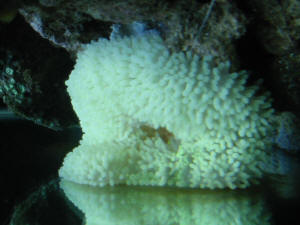
|
Haitian Reef Anemone Good day. <How goes
it? M. Maddox here, earning his keep> I've
read your site and thoroughly enjoy your wealth of knowledge.
<Thanks, so do I> I recently started a second marine tank (my
other is a 75g Reef). My wife wanted an anemone and a pair
of clowns in the bedroom. <Spiffy ;]> So I went to my
local LFS and purchased a Haitian Reef Anemone (yes I now know a poor
choice *gasp*). <Do you mean Condylactis spp? If so,
they're not difficult to keep, as anemones go. If not,
scientific name, please?> I placed the anemone in my
cycled tank after the acclimation process. <Unless you're using
a significant amount of LR\LS from your main tank I wouldn't add an
anemone for several months or more> The next morning I
found the anemone dead and in pieces all over the tank. A
classic epic of Anemone v. Powerhead. <Why is it that everyone who
has an anemone insists on using powerheads? I see\hear this
all the time! At least cover the intakes with foam> Needless to say
the powerhead won. <They usually do> My question is
this: What steps do I need to take before putting anything
else in the tank? Did the untimely death pollute my tank?
<Probably not much> Is so what steps, if any, can be taken to
render it safe for marine life again? <Wait a few months, research
anemone care, cover the PH intake with foam, or preferably, get rid of
them in exchange for better means of flow> Thanks Marc <Anytime -
M. Maddox>
Re: Haitian Reef Anemone Thank you for the
reply. I don't intend to attempt anemones again.
<They do have very strict requirements> Going to be a FOWLR tank.
<I want a 500g one with an Arothron hispidus...buy it for me? =D>
But will keep the rest of the information handy for the future.
<Cool - good luck with the FO!> Marc <M. Maddox>
Condylactis & Epicystis anemone care 11/26/03
I've inherited a Condylactis and an Epicystis
anemone. Can you tell me a bit more about their
needs? <hmm... what questions do you have beyond what is
posted on the web sight for history, selection, husbandry? Lighting for
cnidarians, etc> From reading your web site & Bob Fenner's
CMA book, it appears the Condylactis does need fairly bright light, but
I have trouble finding other info (e.g. water movement &
feeding). <feed the standard meats of marine origin
finely minced/// 3-5 times weekly as a zooplankton substitute>
I've got the Condylactis placed on some LR about 6-7" below
the water surface (420W of VHO lighting) with moderately light flow.
<the lighting is good... but the water flow should be moderate to
strong random turbulent (not laminar)> The Epicystis is rooted in
the gravel (I think) about 17" below the surface, with very light
flow. Any hints? <rather typical for this hardy
genus... fed regularly here and it likely will be fine> If I need to
move the Epicystis to either a brighter or more rapidly flowing
location, how do I do it with little stress? What do I feed
them & how frequently? Thanks! Hy <do refer to the article we
have posted on WWM for feeding reef invertebrates... it regards corals
and anemones in kind. Anthony>
Anemone (potentially temperate) husbandry... My
daughter came home from sea camp in North Carolina with a sea Anemone.
It looks like a Heteractis malu, from your website.
<Well, if she found it in the ocean, it can't be a H. malu
because these are only found in the Pacific. Maybe she bought it at a
store? If she did take if from the ocean, it's either a Condylactis
anemone or some sort of temperate anemone (not sure what the water temp
off of NC is year round).>
It has high sentimental value. We first tried to house it in
a very small 3 gal tank, along with a few algae eaters and a
mussel-that it was attached to. We were convinced to invest
in a larger tank-10 gal. We did the live sand and mixed up Instant
Ocean. Each time we moved it, we took whatever water it was
with, and added however much we needed. We bought a heater
and put it on low. The temperature quickly got "too
high", 80 deg F, so we shut it off. It is now about 70
F, The Anemone does not seem to be stressed
out. It is spread out and has moved location to a purchased
rock. However despite the water conditioners and stress aides, the
anemone seems to have contracted Ick.
<Only fish can contract Ich, what is it that makes you think it has
this disease?>
What do we do now, what do we feed this, do we need reef lighting?
<Yes, at least a pair of 32w power compacts or more assuming
it's a bought H. malu, few standard output fluorescents
or more if it's a Condylactis, and if it's a temperate anemone
you'll need a bunch more light as well but I doubt it will survive
for more than a few months.>
The tank is from Marineland and has a "wheel, wet dry filter on
the top.
<This makes it difficult to impossible to add the additional
lighting that this guy needs.> I would very much appreciate some
quality advice! <Need more details about where this critter came
from! -Kevin>
Antler Anemone? ID - 2/23/03 Hi Anthony, Been out
of the country on a dive vacation or would have gotten back to you
sooner :) <no worries... I'm still out of my mind> They came
with a green tree from friend a local university that works with fish
breeding and coral propagation. There's probably a
variety of stuff in their holding tanks but as far as I know don't
import anything. <and they probably QT strictly (seriously) as
educated academics/scientists... something we all need to do without
fail as aquarists> After being away, the critters that are visible
have noticeably grown but are still in the bottom third of the
tank. In the past 2 weeks, some others from the local reefer
group and RC have suggested Lebrunia which I guess gives me more
concern for my stupid clowns. <Lebrunia/Antler anemones
seems very hard to believe for a number of reasons like (Atlantic
distribution, Pacific vehicle you've cited, its proclivity for
sitting in the open on the reef, etc). Very doubtful... but possible.
See our WWM pics of this species here:
http://www.wetwebmedia.com/marine/inverts/cnidaria/anthozoa/twaanemones.htm
> I don't know if these pictures are any better... <much
better .... its just hard to be certain when they are this small>
Right now, the stalks are thicker and the polyps are much more fully
extended (all slightly larger than quarter now). I can send
you the full size images for future use if you want.
<that would be wonderful... please do! If high-res, perhaps we can
sneak them into the next book <G>. In the meantime, do try to
notice if there is a very dramatic change with this anemone at night. A
Lebrunia will not retract like a typical anemone but put out large and
exaggerated feeding tentacles. Please let us know :) Do feed these
little buggers well at any rate. They are cute whatever they are (at
least until we ID them <VBG>)> Anyways any advice on keeping
both these and livestock (2 clowns and 1 cherub angel) healthy would be
great. Thanks again. Aven
<best regards, Anthony>
|
|

